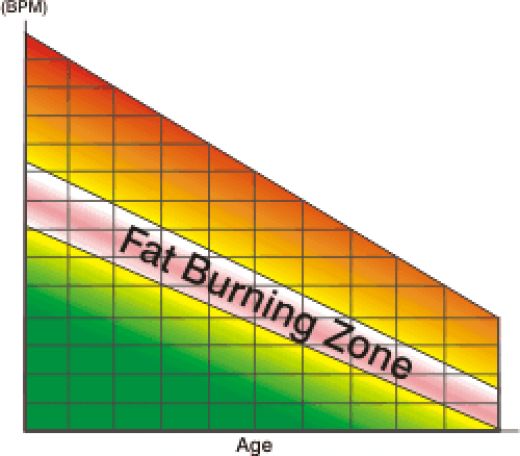We know many of you come to us to invest in exercise equipment to aid you in losing weight, and for many of you specifically losing fat. As stated in this article, cardio is a one of the best ways to get rid of that excess fat. With this being no surprise I’m sure you’ve been told that the way to do this is to workout in your “Fat-Burning Zone”, but there are rumors that this may be a myth.
First let’s begin with exactly what is the “Fat-Burning Zone”?! This “zone” is supposed to be the ideal intensity at which you burn more fat than you do glucose, which is your body’s other main fuel for energy during exercise.
This zone is at the lower end of your target heart rate zone, about 40-60% of your maximum heart rate, which is about the equivalent to taking a walk or slow bike ride. In this range you are said to burn about 60% fat and 40% glucose. Since you are burning a higher percentage of fat in this range, in theory you would think you are resulting in a higher fat loss, yet this theory may have a few misconceptions.
The truth to the fat-burning zone theory, according to this article from exercise.about.com, is that yes “the body does burn a higher percentage of calories from fat in the fat burning zone or at lower intensities. However, at higher intensities (70-90% of your maximum heart rate), you burn a greater number of overall calories.”
An article from active.com, which you can read more about here, agrees with the previous article mentioned. They state, “the body burns a great percentage of fat at lower intensities than at higher intensities. At lower intensities the body may burn 50% of the calories from fat, while at higher intensities it may only burn 35%. But at higher intensities you burn way more total calories – and more fat calories overall – than you do at lower intensities.”
Instead of always trying to stay in that “fat-burning zone” you should be focusing on the total calories burned from fat, not the percentage of fat being burned during the workout. As stated above, higher intensity workouts are going to do just that for you.
Although your body may be using less fat and more glucose for energy during higher intensity sessions, in the end you are still not only burning more fat calories during the workout but well after the workout as well. As stated in this article from MyOnlineHealthGuide.com, you are creating a higher after burn effect with high intensity workouts, your body is continuing to consume oxygen and burn calories up to 48 hours after your workout.
Here is a great chart to explain the differences of low and high intensity workouts from the same above mentioned article from exercise.about.com:
|
Low Intensity – 60-65% MHR |
High Intensity – 80-85% MHR |
|
| Total Calories expended per min. |
4.86 |
6.86 |
| Fat Calories expended per min. |
2.43 |
2.7 |
| Total Calories expended in 30 min. |
146 |
206 |
| Total Fat calories expended in 30 min. |
73 |
82 |
| Percentage of fat calories burned |
50% |
39.85% |
As you see yes you are burning up to 50% calories during low intensity, yet you are still burning slightly more fat calories per workout with higher intensity. And it is that after burn effect we discussed that is going to be higher and last longer with higher intensity workouts, helping you burn more calories, including fat calories.Here is a great 20-minute high intensity treadmill workoutto try to help you get started on your fat burning weight loss path!
Don’t think now you should only be doing high intensity workouts from now on, we do believe lower intensity exercises are still important. They should be incorporated into your weekly workout regimens, as we’ve stated before in a previous post here, so that your body does not get burned out of only doing high intensity workouts.It is not the best choice for weight loss to be trying to stay in that “fat-burning zone” all the time. Instead try doing a mixture of lower intensity a few times a week on top of your few days of higher intensity workouts, to help prevent fatigue while helping increase weight and fat loss.



